1) When the astronauts are putting up the American flag it
waves. There is no wind on the Moon.
The flag is held up
by a horizontal bar and simply moves when it is unfurled and as
the pole is being fixed into position by the astronauts. The
flagpole is light, flexible aluminium and continues to vibrate
after the astronauts let go, giving the impression of blowing in
the wind.
2) No stars are visible in the pictures taken by the Apollo
astronauts from the surface of the Moon.
The Apollo landing
takes place during lunar mornings, with the Sun shining
brightly. The stars are not bright enough in this light to be
captured in the photographs.
3) No blast crater is visible in the pictures taken of the lunar
landing module.
The landing module
touches down on solid rock, covered in a layer of fine lunar dust,
so there is no reason why it would create a blast crater. Even if
the ground were less solid, the amount of thrust being produced by
the engines at the point of landing and take off is very low in
comparison to a landing on Earth because of the relative lack of
gravitational pull.
4)
The landing module weighs 17 tons and yet sits on top of the sand
making no impression. Next to it astronautsí footprints can be seen
in the sand.
The layer of lunar dust
is fairly thin, so the landing module sits on the solid rock. The
dust, whilst blown away by the blast from the descent engines,
quickly settles back on the ground and is under the astronauts when
they begin their moonwalk.
5)
The footprints in the fine lunar dust, with no moisture or
atmosphere or strong gravity, are unexpectedly well preserved, as if
made in wet sand.
The lack of wind on the
moon means the footprints in fine, dry lunar dust arenít blown away
in the way they would be if made in a similar substance on Earth.
6)
When the landing module takes off from the Moonís surface there is
no visible flame from the rocket.
The rockets in the
landing module are powered by fuel containing a combination of
hydrazine and dinitrogen tetroxide, which burn with no visible
flame.
7) If
you speed up the film of the astronauts walking on the Moonís
surface they look like they were filmed on Earth and slowed down.
The best you can say
is: yes, a bit, but not really.
8)
The astronauts could not have survived the trip because of exposure
to radiation from the Van Allen radiation belt.
This claim is largely
based on a claim from a Russian cosmonaut. The short time it takes
to pass through the belt, combined with the protection from the
spacecraft, means any exposure to radiation would be very low.
9)
The rocks brought back from the Moon are identical to rocks
collected by scientific expeditions to Antarctica.
Some Moon rocks have
been found on Earth, but they are all scorched and oxidised from
their entry into the Earthís atmosphere as asteroids. Geologists
have confirmed with complete certainty that the Apollo rocks must
have been brought from the Moon by man.
10)
All six Moon landings happened during the Nixon administration. No
other national leader has claimed to have landed astronauts on the
Moon, despite 40 years of rapid technological development.
This is a favourite
among conspiracy theorists because it needs no evidence but points
the finger at the presidency of Richard Nixon. The fact is that
after the Apollo landings, the race had been won and the money dried
up. The USSR has no interest in coming second, and politicians on
both side realised that lower-orbit missions had much greater
commercial and military potential.
*************************************************
Are Apollo Moon Photos Fake? (by
Ian Williams Goddard)
FOX
Television advanced
the claim that NASA's Apollo Moon missions were a hoax largely
because Apollo photos contain alleged anomalies.
[1] David Percy, an Associate
of the Royal Photographic Society, told FOX: "Our
research suggests that images of the Apollo landings are not a true
and accurate record. In our view the Apollo pictures were faked.
Many of the images are replete with inconsistencies and anomalies." Are
Percy and other Apollo deniers correct? Let's examine their claims.
Examination of
Apollo-Photo "Anomalies"
Illumination in Shadow
FOX narrator: "On the
Moon, the astronaut's only source of light was the Sun. ... Here's
an astronaut who descends into the huge shadow cast from the lunar
module, yet his entire body is still visible. How is it that he is
not shrouded in darkness?" Apollo critic answers: "It's because
there's more than one light source, which means they're not on the
Moon."
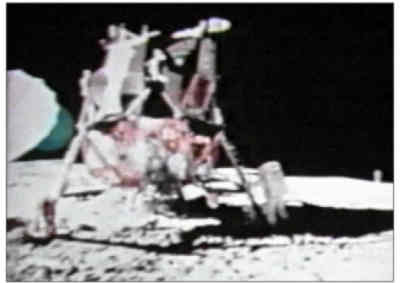 Question: why
is the astronaut in the shadow illuminated?
Answer: surface
reflection of light:
Question: why
is the astronaut in the shadow illuminated?
Answer: surface
reflection of light:
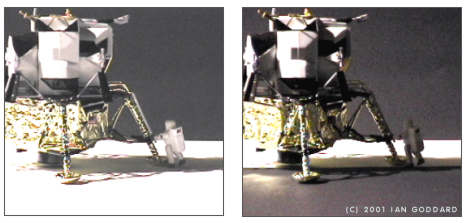
Test: surface
reflection illuminates toy astronaut in shadow.
In second image, foreground reflection is reduced with black
paper.
The
side-by-side photos show a test I conducted with a toy lunar module
and astronaut placed in its shadow as in the Apollo image above. The
two photos show the difference between a reflective gray-paper
foreground and a less reflective black-paper foreground. Foreground
reflectance from the powerful lamp above was sufficient to
illuminate the toy astronaut in the shadow of the toy lunar module.
This simple test demonstrates that Apollo astronauts illuminated in
shadow are not an "anomaly" but a predictable result of sunlight
reflecting off the lunar surface.
FOX narrator: "In
this picture the Sun is directly behind the astronaut, his figure
should be a silhouette, yet even the smallest characteristics of his
suit are recognizable." A photographic expert then says: "He seems
like he's standing in the spotlight. I can't explain that." That
astronaut is in the first of these three photos:
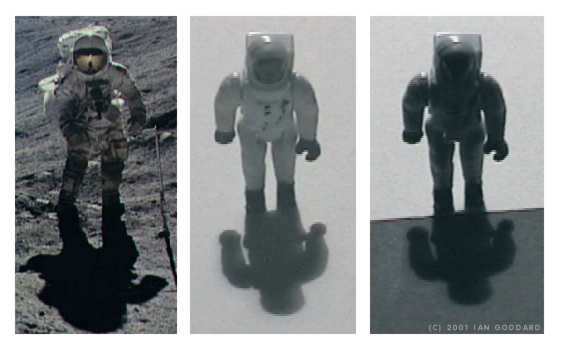 Illumination of Apollo astronaut on left simulates surface
reflection on toy.
Illumination of Apollo astronaut on left simulates surface
reflection on toy.
The
toy-astronaut test shows us the difference between a reflective
foreground (gray paper) and a less reflective (black paper)
foreground. Apart from surface reflection, the only light source was
the lamp behind the toy. These tests show that illumination of
astronauts in shadow is not an
anomaly but a predictable result of surface reflection. In addition
to surface reflection, light from the Earth in the sky above the
Moon is 68 times brighter than a full Moon seen from the Earth.
[2]
Different Shadow Directions
FOX narrator: "On
the Moon, the astronaut's only source of light was the Sun. Yet in
this photograph from Apollo 14, the shadows are cast in different
directions suggesting multiple light sources." Dave Percy: "The
shadows cast by the rocks in the foreground should have been
east-west like the LEM [lunar module] shadow."
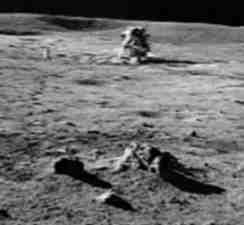
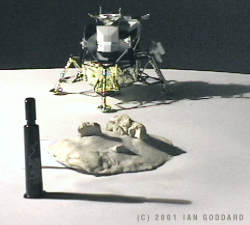
Test: slanted
surface alters shadow direction on Moon-rock model under
one light. Identical ground slant can be detected in
Moon photo on left.
The photo on the right shows one light shining
on a clay model of Moon rocks and ground. This test simulates the
shadow "anomaly" in the Apollo photo and demonstrates that ground
slant -- in addition to light source and viewer position -- is an
important factor in shadow direction. The LEM in the background and
the magic marker in the foreground serve as shadow controls, showing
the direction shadows on non-slanted ground run in the area. The
direction of model-rock shadows differs from control, running
downhill with the slant of the ground upon which their shadows are
cast. (Note: the toy LEM in the background is further from the lamp
in weaker light than in the first test, yet the toy astronaut on it
is still illuminated in shadow by surface reflection.)

Other examples in Apollo photos of shadows following
ground slant. On left shadows run down crater. On right
run down Hadley Rille.
Just as the shadows follow the topography of the lunar ground in
these two examples, the alleged shadow "anomaly" in the previous
Apollo photo is clearly a result of ground slant and therefore is
not a genuine anomaly indicating fakery. Apollo critics cite other
examples of shadow-direction "anomalies," all of those I've viewed
are obviously a result of irregular ground slant.
Identical Backgrounds
FOX Narrator: "These
two photos seem to have the same mountain backdrop, yet the lunar
module is only visible in one of them. Seemingly impossible since
the LEM never moved, and its based remained even after the mission.
Some suggest the same artificial backdrop was used when shooting two
entirely separate pictures."
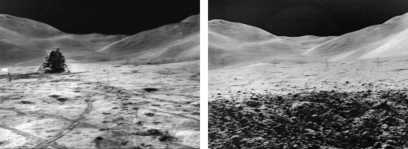
Examination of Apollo-15 photos clearly proves
that the mountains in the background are so large and distant that
they can be seen without changing their appearance from myriad
points of view with or without the LEM in the foreground.
[3]
The mountains above are the Apennine
Front on the left and Mount
Hadley Delta on the
right of each photo.
[4] The astronauts went up
to those mountains and walked on Hadley Delta. How could they walk
into a fake backdrop?
See this
lunar panorama (scroll
to the right) showing Apollo-15 astronaut David Scott at the base of
Mount Hadley Delta with the Apennine Front behind him. Here is
another view of the Apennine Front from the slope of Hadley Delta. Here is
a panorama with the fresh crater in the foreground seen above. Here
are other views of these mountains from various locations: A, B, C, D, E, F, G, H.
Those photos show that the known and mapped lunar mountains in
question are not a fake backdrop but are real three-dimensional
mountains around the astronauts. The lunar mountains in question are
also seen in the following 360-degree panoramic view of the Apollo
15 landing site.
[5]

This panorama, a composite of single photos,
shows that theApennine Front and Hadley
Delta can be viewed
without the LEM in the foreground, since when the camera views them
at 180 degrees (as marked below the panorama), the LEM is behind the
camera at 0 degrees, out of the picture frame for that photo. The
panorama also gives a sense of how far away the mountains are.
Because there is no atmosphere on the Moon, objects do not fade over
distance and thus distant mountains can appear very close, as they
do in the two photos FOX showed.
The
claim that these known and mapped Moon mountains that are viewed
from myriad angles in Apollo photos [3] are really a fake backdrop
that was accidently used in two staged studio sets on Earth is not a
theory but an exercise in silliness. BadAstronomy.com explains the
other example FOX presented of an alleged identical background
"anomaly." [6]
Crosshair Knockout
FOX narrator: "For
reference, crosshairs were permanently etched into the lunar
cameras, so they would have to appear on top of every image. But in
this photo, a crosshair is behind a part of the lunar rover." David
Percy then opines: "This situation is impossible and has to be the
result of technical manipulation and doctoring of the image."Clue: in
each example FOX showed of an object appearing to be over a
crosshair, the obtrusive object was sunlit and bright white, such as
these examples:
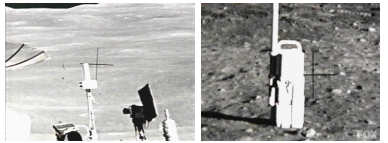
Question: why do
crosshairs vanish over sunlit white objects?
Answer: strong
luminosity can washout thin lines.

Test: hair across
lens is washed out by sunlit white paper.
With no atmosphere on the Moon, sunlight is stronger.
In
this test a strand of hair was taped across a camcorder lens, which
was then pointed at a sunlit white paper. While my test failed to
vanish the hair-line completely, it demonstrates that diffuse solar
reflection on a white surface can wash out a thin line. This result
is sufficient to render the phenomenon of crosshair vanishing over
sunlit white objects not anomalous.
Also reflective intensity and thus crosshair-knockout potential
would be greater on the Moon with no atmosphere to reduce solar
intensity. Click here to
see partial and complete crosshair knockout against white clouds in
an exoatmospheric photo. [7]
Conclusion
None of the alleged photographic anomalies
presented by FOX TV are true anomalies and thus they evidence
neither manipulation nor a hoax. In the future Goddard's
Journal shall examine
alleged physical anomalies said to be evidence that man never set
foot on the Moon.
**************************
[1] FOX
Television Network: Conspiracy
Theory: Did We Land on The Moon? February
15, 2001.
[2] Fortean
Times: Percy and the
Astro-Nots. 1997.
[3] Apollo
15 Digital Picture Library & JSC
Digital Image Collection.
[4] NASA
Photo ID: AS15-82-11057
[5] Apollo
Lunar Surface Journal.
Thanks to David Harland, Mike Constantine, and Dave Byrne who
assembled the Apollo-15 panoramas and to Ken Glover who helped me
update links to them.
[6] BadAstronomy: Fox
TV and the Apollo Moon Hoax. 02/12/2001.
[7] Thanks
to Michael
de Kooter for
finding this
crosshair-knockout example.